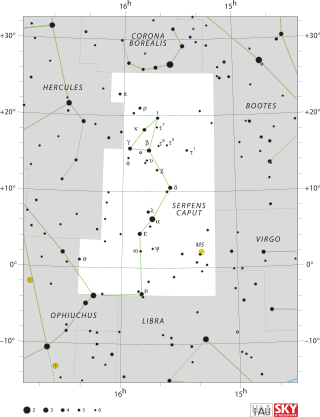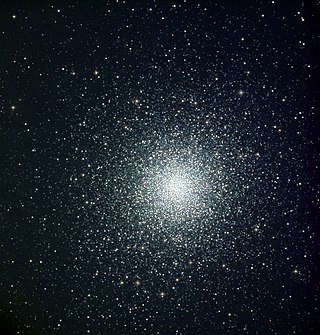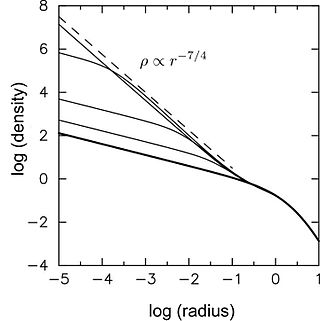
A globular cluster is a spheroidal conglomeration of stars. Globular clusters are bound together by gravity, with a higher concentration of stars towards their centers. They can contain anywhere from tens of thousands to many millions of member stars. Their name is derived from Latin globulus. Globular clusters are occasionally known simply as "globulars".

Serpens is a constellation in the northern celestial hemisphere. One of the 48 constellations listed by the 2nd-century astronomer Ptolemy, it remains one of the 88 modern constellations designated by the International Astronomical Union. It is unique among the modern constellations in being split into two non-contiguous parts, Serpens Caput to the west and Serpens Cauda to the east. Between these two halves lies the constellation of Ophiuchus, the "Serpent-Bearer". In figurative representations, the body of the serpent is represented as passing behind Ophiuchus between Mu Serpentis in Serpens Caput and Nu Serpentis in Serpens Cauda.

Star clusters are large groups of stars held together by self-gravitation. Two main types of star clusters can be distinguished: globular clusters are tight groups of ten thousand to millions of old stars which are gravitationally bound, while open clusters are more loosely clustered groups of stars, generally containing fewer than a few hundred members, and are often very young. Open clusters become disrupted over time by the gravitational influence of giant molecular clouds as they move through the galaxy, but cluster members will continue to move in broadly the same direction through space even though they are no longer gravitationally bound; they are then known as a stellar association, sometimes also referred to as a moving group.

The cosmic distance ladder is the succession of methods by which astronomers determine the distances to celestial objects. A direct distance measurement of an astronomical object is possible only for those objects that are "close enough" to Earth. The techniques for determining distances to more distant objects are all based on various measured correlations between methods that work at close distances and methods that work at larger distances. Several methods rely on a standard candle, which is an astronomical object that has a known luminosity.

An Einstein ring, also known as an Einstein–Chwolson ring or Chwolson ring, is created when light from a galaxy or star passes by a massive object en route to the Earth. Due to gravitational lensing, the light is diverted, making it seem to come from different places. If source, lens, and observer are all in perfect alignment (syzygy), the light appears as a ring.

Messier 70 or M70, also known as NGC 6681, is a globular cluster of stars to be found in the south of Sagittarius. It was discovered by Charles Messier in 1780. The famous comet Hale–Bopp was discovered near this cluster in 1995.

Eta Tucanae, Latinized from η Tucanae, is a probable binary star system in the southern constellation of Tucana, a few degrees to the north of Epsilon Tucanae. It is visible to the naked eye as a dim, white-hued point of light with an apparent visual magnitude of +5.00. parallax measurements provide a distance estimate of about 154 light years from the Sun, and it is drifting further away with a mean radial velocity of +32.5 km/s. It is a member of the 30 million year old Tucana-Horologium association of co-moving stars.
Lambda1 Tucanae is the Bayer designation for one member of a pair of stars sharing a common proper motion through space, which lie within the southern constellation of Tucana. As of 2013, the pair had an angular separation of 20.0 arc seconds along a position angle of 82°. Together, they are barely visible to the naked eye with a combined apparent visual magnitude of 6.21. Based upon an annual parallax shift for both stars of approximately 16.5 mas as seen from Earth, this system is located roughly 198 light years from the Sun.

IC 2391 is an open cluster in the constellation Vela consisting of hot, young, blueish stars, some of which binaries and one of which is a quadruple. Persian astronomer A. a.-R. Al Sufi first described it as "a nebulous star" in c. 964. It was re-found by Abbe Lacaille and cataloged as Lac II 5.
Palomar 14 is a globular cluster located in the constellation Hercules. It is a member of the Palomar Globular Clusters group. Palomar 14 was discovered in 1958 by Sidney van den Bergh and Halton Arp during inspection of the photographic plates from the Palomar Sky Survey. This is a round, diffuse cluster located in the outer halo of the Milky Way galaxy. It is about 3–4 billion years younger than a typical galactic cluster.
Stanislav George Djorgovski is an American scientist and scholar. He obtained his B.A. in astrophysics in 1979 at the University of Belgrade. After receiving his PhD in astronomy from U.C. Berkeley in 1985, he was a Harvard Junior Fellow until 1987 when he joined the faculty at the California Institute of Technology, where he is currently a professor of astronomy and data science.

Bahcall–Wolf cusp refers to a particular distribution of stars around a massive black hole at the center of a galaxy or globular cluster. If the nucleus containing the black hole is sufficiently old, exchange of orbital energy between stars drives their distribution toward a characteristic form, such that the density of stars, ρ, varies with distance from the black hole, r, as

NGC 3311 is a supergiant elliptical galaxy located about 190 million light-years away in the constellation Hydra. The galaxy was discovered by astronomer John Herschel on March 30, 1835. NGC 3311 is the brightest member of the Hydra Cluster and forms a pair with NGC 3309 which along with NGC 3311, dominate the central region of the Hydra Cluster.

NGC 708 is an elliptical galaxy located 240 million light-years away in the constellation Andromeda and was discovered by astronomer William Herschel on September 21, 1786. It is classified as a cD galaxy and is the brightest member of Abell 262. NGC 708 is a weak FR I radio galaxy and is also classified as a type 2 Seyfert galaxy.

DS Tucanae is a binary star system 144 light years away in the constellation of Tucana. It has an apparent visual magnitude of 8.5, and is a RS Canum Venaticorum variable. The system is notable for being young as a member of the 45 Myr old Tucana-Horologium moving group and for the primary star hosting the confirmed exoplanet DS Tucanae Ab, discovered by THYME, using TESS.












